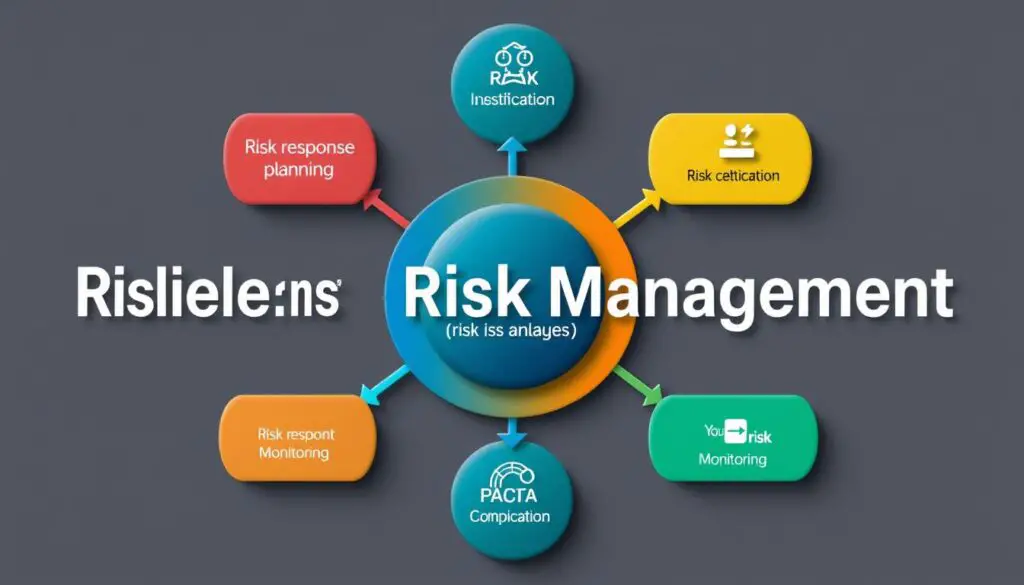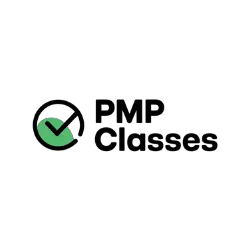Project management is complex, and risk management is key to success. Learning from 7 real-world projects can help you understand how to manage risks. This knowledge is essential for your PMP Risk Management Study and getting your Project Management Certification.
Risks can pop up at any time, so it’s important to spot and assess them well. Studies show that some risks can raise costs by about 5% of the project budget. Knowing this helps you prepare and find ways to reduce risks.
This guide will show you how past projects can teach you about risk management. You’ll learn to identify risks, update your risk register, and come up with good responses. You’ll also see how new technologies can add to risk levels. This is great for anyone looking to improve their project risk management skills and do well in their PMP Certification.
Importance of Project Risk Management
Knowing how vital project risk management is can really boost your project’s success. Studies show that up to 70% of projects fail. This shows how critical it is to manage risks well.
Ignoring risk management can lead to a 50% chance of project failure. This can cause big financial losses and missed opportunities. In fact, poor project performance can result in a 10% loss for every dollar spent.
Understanding Project Success Rates
Good risk management can cut down project failures by 30-50%. Companies that manage risks well are 20% more likely to hit their goals on time and within budget. Also, regular risk assessments can reduce project delays by 35%.
Different industries see big differences in success rates. Those that use formal risk management see a 70% higher success rate than those that don’t.
The Financial Impact of Neglecting Risk Management
The financial effects of not managing risks are huge. Poor planning and oversight can lead to unexpected challenges, as 77% of companies have faced. Using risk management strategies can make decision-making 25% better.
It also helps in better resource allocation, improving project efficiency by 25%. Risk management also boosts communication, making stakeholders 15% happier.
| Statistical Data | Impact |
|---|---|
| 70% of projects fail | High need for effective risk management |
| 50% likelihood of project failure without risk management | Significant financial losses |
| 10% potentially lost in investments | Substantial financial repercussions |
| 30-50% reduction in project failures | Improved project success rates |
| 20% more likely to meet deadlines | Increased project efficiency |
| 35% decrease in delays | Streamlined project execution |
Overview of Risk Management Components
Understanding the key parts of risk management is essential for any project’s success. Each project phase needs careful attention to spotting risks, assessing them, and planning how to handle them. Spotting risks first is often missed but is very important.
Studies show that 77% of companies face surprises because they didn’t see threats coming. This shows how critical it is to focus on this step.
Identifying Risks in Projects
Good risk management starts with a detailed risk spotting process. This step is about finding possible problems that could slow down the project. About 60% of projects use past data to spot risks.
A culture that encourages sharing risks can make teams work better together. It can cut down fear by about 30%. Also, 35% of companies do regular risk checks to keep their risk plans up to date.
Evaluating Risks and Their Impacts
After spotting risks, the next step is to figure out how big of a problem they could be. This means looking at how likely and severe each risk is. Most teams sort risks into high, medium, and low levels.
About 67% of teams use methods to guess how likely and big a risk is. Around 40% use more exact methods like Monte Carlo simulations. Good evaluation helps make a clear plan to handle risks.
Planning Effective Risk Responses
Planning how to deal with risks is key to avoiding problems. This step is about making plans to tackle the risks found and evaluated. It’s important to make sure the right resources are used for the most important risks.
Managers often save some money for risks they didn’t see coming. A good risk plan should say who is in charge, how much money is needed, and what resources are needed. This can help projects succeed more often, by 30% to 50%.

| Risk Management Component | Description | Importance |
|---|---|---|
| Identifying Risks | Recognizing possible threats in the project. | Helps avoid surprises. |
| Evaluating Risks | Looking at how likely and big each risk is. | Helps use resources wisely. |
| Planning Risk Responses | Making plans to deal with risks. | Helps use resources well and reduce impacts. |
7 Real-World Project Examples to Enhance PMP Risk Management Study: A Guide
Looking at real projects gives us great insights into managing risks. Each example shows different ways to handle risks in various fields. These lessons can really help you understand risk management better.
The Gordie Howe International Bridge Project
The Gordie Howe International Bridge is a big project that shows the importance of good management and talking to stakeholders. It focuses on avoiding delays, sticking to the budget, and keeping the community happy. These are key for a project’s success over time.
Fujitsu’s Early-Career Project Management Approach
Fujitsu trains young project managers to tackle real challenges. This training helps them spot risks and plan how to deal with them. It prepares them for the obstacles they might face in their work.
Vodafone’s Complex Technology Project
Vodafone’s project uses PMI standards to handle complex situations. It has a detailed list of risks, like data security problems. This helps prevent issues and improve the project’s quality.
Fehmarnbelt Project Insights
The Fehmarnbelt project shows how important risk management is in big construction projects. It uses a detailed risk list to track and manage risks. This helps avoid unexpected costs and keeps the project on track.
Lend Lease Project Risk Management Practices
Lend Lease uses creative ways to manage risks. It focuses on talking openly and solving problems quickly. This approach helps avoid delays and keeps the team working well together.
| Project | Key Focus Areas | Risk Management Strategies | Insights |
|---|---|---|---|
| Gordie Howe International Bridge | Infrastructure, Stakeholder Engagement | Mitigating Delays, Budget Adherence | Community relations are key for long-term success. |
| Fujitsu’s Early-Career Approach | Skill Development, Training | Identifying Risks, Planning Responses | Aligns with project needs for thorough training. |
| Vodafone Technology Project | Technology, Security | Risk Register, Mitigation Strategies | Focuses on avoiding problems and improving quality. |
| Fehmarnbelt Project | Construction, Risk Tracking | Comprehensive Risk Register | Essential for managing costs and unexpected work. |
| Lend Lease Practices | Innovation, Communication | Proactive Risk Management, Resource Management | Reduces delays through good team communication. |
Best Practices for Implementing Risk Management
Effective risk management starts with the right practices for your project. It’s about a strategic plan to engage stakeholders and use the best risk management methods. This way, your project can better face and overcome challenges.
Engaging Stakeholders Effectively
Getting stakeholders involved is key to good risk management. They often spot risks that the team might miss. Here are some tips for working well with stakeholders:
- Maintain open lines of communication: Regular updates and talks help build trust and keep everyone informed.
- Involve stakeholders in risk identification: Their fresh views can uncover risks that might be overlooked.
- Encourage feedback: Useful feedback from stakeholders can improve the project’s risk management plan.
Utilizing Risk Management Methodologies
Using proven risk management methods helps you handle project uncertainties better. Tools like PRINCE2 or Agile provide a clear plan for managing risks. The benefits include:
- Continuous risk assessment: Instead of just one check, risks are checked over and over, helping projects adjust to changes.
- Data-driven decision-making: Using detailed stats helps spot risks early and increases project success.
- Proactive risk management: This method lets teams use chances while avoiding risks, making the project stronger.

Challenges in Project Risk Management
Managing risks well is key to a project’s success. You might face many challenges that affect timelines, budgets, and success. Knowing common risks helps you steer clear of problems and use the right strategies to manage them.
Common Risks Encountered in Projects
Here are some common risks in projects:
- Scope Creep: About 60% of projects see scope changes, causing delays of 15-20%.
- Poor Communication: More than 50% of project failures come from bad communication.
- Resource Unavailability: 30% of project managers struggle because needed resources are missing.
- Inadequate Budgets: 70% of project managers worry about not having enough money.
- Resistance to Change: Over 70% of teams face resistance when trying to adapt to new things or tech.
Mitigation Strategies for Successful Risk Management
Here are some ways to improve your risk management:
- Establish Clear Goals: Make sure everyone knows the project’s goals to avoid confusion, which can lower performance by 40%.
- Develop Contingency Plans: Projects with backup plans have a 35% higher chance of success when facing surprises.
- Effective Stakeholder Engagement: Getting stakeholders involved in risk management can increase risk spotting by 20%.
- Utilize Formal Risk Management Methodologies: Projects using formal methods are 30% more likely to stay on budget.
- Continuously Update Mitigation Plans: Keeping plans current can cut the impact of risks by 25%.

By knowing the challenges and risks in project risk management, you can take steps to improve your project. This effort not only boosts project success but also builds a culture of teamwork and responsibility.
Future Trends in Project Risk Management
As technology advances, understanding future trends in risk management is key. New tools and analytics are changing how we spot and track risks. These tools give us real-time data, helping us make better choices. For companies to stay ahead, using these tools for risk management is essential.
The Role of Technology in Risk Management
Technology is set to greatly improve project outcomes. A study from MIT found that using generative AI can boost worker performance by up to 40%. Gartner’s 2019 study also suggests that AI and machine learning will cut down project management tasks by 80% by 2030. Teams need to adapt to these changes to manage risks effectively.
Adapting Risk Management Strategies in an Agile Environment
With more projects using Agile, adjusting risk management strategies is critical. Research shows that 70% of projects fail, making good risk management even more important. Teams that are flexible can quickly handle changes and avoid big problems. Skills like problem-solving and analytical thinking are key to success in this new environment. Regular reviews and assessments keep risk management a top priority in Agile projects.

| Future Trends | Implications | Skills Required |
|---|---|---|
| Advanced AI Integration | Increased efficiency, reduced errors in risk assessment | Critical thinking, data analytics |
| Automation of Tasks | Streamlined project management processes | Tech-savviness, adaptability |
| Agile Methodologies | Improved flexibility and responsiveness | Collaboration, communication |
| Sustainability Focus | Enhanced consumer trust and market engagement | Innovative thinking, strategic planning |
Conclusion
As we conclude this guide on project risk management, it’s clear that effective risk management is key to success. By learning from real-world examples, you can improve your PMP studies. This means using methods that involve stakeholders and improve risk management.
Improving PMP studies means more than just spotting risks. It’s about creating strategies to deal with them. The data shows that 70% of IT project failures come from bad risk management. This shows the importance of a strong risk management process.
Using tools like Monte Carlo analysis can help predict project timelines and costs. This leads to better decisions. As you move forward in your PMP journey, use the lessons from this guide to face project risks confidently.
The knowledge you gain will help you manage projects better and stay ahead of uncertainty. Investing in project risk management skills will help you succeed in your projects and career.
Source Links
- 16. Risk Management Planning
- How to Fill in Your PMP Application [With Guide & Examples]
- PMP Exam Questions And Answers – Risk Planning – The Projex Academy For Professional Project Managers
- 5 Real-World Project Risk Management Case Studies You Should Know
- The Importance of Risk Management in Project Management
- PMP Risk Management Process for Project Success
- Key Components of an Effective Risk Management Plan
- Project Risk Management: 5 Essential Case Studies to Learn From
- Risk Register: A Project Manager’s Guide with Examples [2024] • Asana
- Project Management Certificate Program
- Project Risk Management Strategies: Best Practices for Identifying, Assessing, and Mitigating Risks in Project Management
- Nine Best Practices — Framework Founded on Risk Management — Part 2: Risk Management References
- 19 Real Life Project Management Challenges You Face, And How To Effortlessly Overcome Them
- Real-world scenarios and effective Risk Management Techniques
- 9 Major Project Management Trends in 2025
- Project Risk Management Insights: 5 Case Studies You Can’t Afford to Miss
- Top 10 Risk Management Tools for Effective Decision Making
- Understanding the Monte Carlo Analysis in Project Management – Project Management Academy Resources




